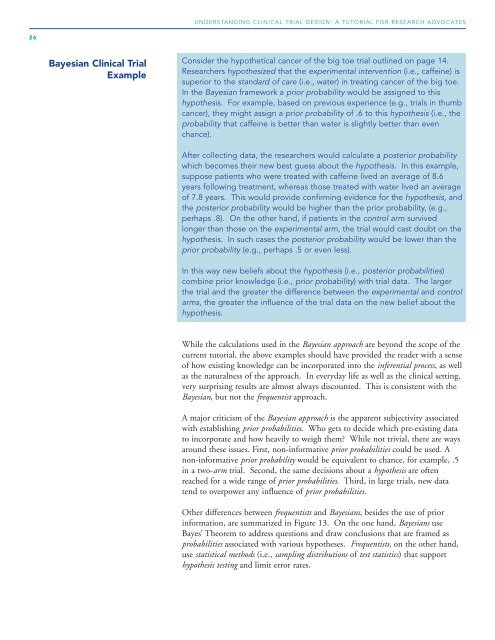Understanding Clinical Trial Design - Research Advocacy Network
Understanding Clinical Trial Design - Research Advocacy Network
Understanding Clinical Trial Design - Research Advocacy Network
You also want an ePaper? Increase the reach of your titles
YUMPU automatically turns print PDFs into web optimized ePapers that Google loves.
26<br />
Bayesian <strong>Clinical</strong> <strong>Trial</strong><br />
Example<br />
UNDERSTANDING CLINICAL TRIAL DESIGN: A TUTORIAL FOR RESEARCH ADVOCATES<br />
Consider the hypothetical cancer of the big toe trial outlined on page 14.<br />
<strong>Research</strong>ers hypothesized that the experimental intervention (i.e., caffeine) is<br />
superior to the standard of care (i.e., water) in treating cancer of the big toe.<br />
In the Bayesian framework a prior probability would be assigned to this<br />
hypothesis. For example, based on previous experience (e.g., trials in thumb<br />
cancer), they might assign a prior probability of .6 to this hypothesis (i.e., the<br />
probability that caffeine is better than water is slightly better than even<br />
chance).<br />
After collecting data, the researchers would calculate a posterior probability<br />
which becomes their new best guess about the hypothesis. In this example,<br />
suppose patients who were treated with caffeine lived an average of 8.6<br />
years following treatment, whereas those treated with water lived an average<br />
of 7.8 years. This would provide confirming evidence for the hypothesis, and<br />
the posterior probability would be higher than the prior probability, (e.g.,<br />
perhaps .8). On the other hand, if patients in the control arm survived<br />
longer than those on the experimental arm, the trial would cast doubt on the<br />
hypothesis. In such cases the posterior probability would be lower than the<br />
prior probability (e.g., perhaps .5 or even less).<br />
In this way new beliefs about the hypothesis (i.e., posterior probabilities)<br />
combine prior knowledge (i.e., prior probability) with trial data. The larger<br />
the trial and the greater the difference between the experimental and control<br />
arms, the greater the influence of the trial data on the new belief about the<br />
hypothesis.<br />
While the calculations used in the Bayesian approach are beyond the scope of the<br />
current tutorial, the above examples should have provided the reader with a sense<br />
of how existing knowledge can be incorporated into the inferential process, as well<br />
as the naturalness of the approach. In everyday life as well as the clinical setting,<br />
very surprising results are almost always discounted. This is consistent with the<br />
Bayesian, but not the frequentist approach.<br />
A major criticism of the Bayesian approach is the apparent subjectivity associated<br />
with establishing prior probabilities. Who gets to decide which pre-existing data<br />
to incorporate and how heavily to weigh them? While not trivial, there are ways<br />
around these issues. First, non-informative prior probabilities could be used. A<br />
non-informative prior probability would be equivalent to chance, for example, .5<br />
in a two-arm trial. Second, the same decisions about a hypothesis are often<br />
reached for a wide range of prior probabilities. Third, in large trials, new data<br />
tend to overpower any influence of prior probabilities.<br />
Other differences between frequentists and Bayesians, besides the use of prior<br />
information, are summarized in Figure 13. On the one hand, Bayesians use<br />
Bayes’ Theorem to address questions and draw conclusions that are framed as<br />
probabilities associated with various hypotheses. Frequentists, on the other hand,<br />
use statistical methods (i.e., sampling distributions of test statistics) that support<br />
hypothesis testing and limit error rates.


